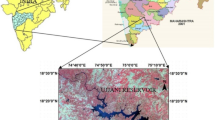Abstract
As per recommendations of Working Group for National Action for Reservoir Sedimentation Assessment, National Institute of Hydrology has taken up study on sedimentation for 25 reservoirs in India during X plan period using remote sensing technique. One such study for Hirakud reservoir in Mahanadi basin in Orissa for year 1999–2001 is described here. Reservoir’s original utilizable and gross volumes were 5818 and 8136 M m3, respectively. Minimum draw down level (MDDL) and full reservoir level (FRL) for reservoir are 179.83 and 192.02 m, respectively. Linear Imaging Self Scanning (LISS)- III data of Indian Remote Sensing Satellites (IRS) 1C and 1D, covering elevation range between 180.68 and 191.89 m, were used. Rule based classification was applied to ‘water index’ and radiances of near infrared band to determine water spread area. Revised live storage capacity was 4842 M m3. The silt index for the live storage area was 2.623 ha m (100 km2 year)-1 (0.376 % of live storage or 21.9 M m3 year-1). Total live storage lost in sedimentation was 984 M m3 (16.90 % of live storage).
Similar content being viewed by others
References
Bhargava, D.N., Agrawal, C.K., Tiagi, S.S. and Verma, R.S. (1989). Sedimentation of reservoirs in U.P. In: Third International Workshop on Alluvial River Problems (TIWARP), held at Univ. Roorkee from March 2–4, 1989. Oxford and IBH, New Delhi, pp. 197–208.
Goel, M.K. and Jain, S.K. (1996). Evaluation of reservoir sedimentation using multi-temporal IRS-1A LISS-II data.Asian- Pacific Remote Sensing and GISJ.,8(2): 39–43.
Goel, M.K., Jain, S.K. and Agarwal, P.K. (2000). Reservoir sedimentation study of Bargi dam using satellite data. CS/AR-18/1999-2000, National Institute of Hydrology, Roorkee.
Gupta, S.C., Sharma, S. and Praveen Kumar (1998). Sedimentation survey of Hirakud reservoir through satellite remote sensing techniques. Remote Sensing Directorate, Central Water Commission, New Delhi.
Jain, S.K., Singh, P. and Seth, S.M. (2002). Assessment of sedimentation in Bhakra reservoir in the Western Himalayan region using remotely sensed data.Hydrological Sciences J.,47(2): 203–212.
Mahto, S and Patil, T.S. (2005). Short term training programme on sedimentation planning for reservoir. May 30– June 3, National Water Academy, Pune.
Manavalan, P., Sathyanath, P. and Rajegowda, G.L. (1993). Digital image analysis techniques to estimate waterspread for capacity evaluations of reservoirs.Photogrammetric Engineering and Remote Sensing,59(9): 1389–1395.
Murthy, B.N. (1977). Sedimentation studies in reservoirs. Technical Report No. 20, Central Board of Irrigation and Power, New Delhi.
Author information
Authors and Affiliations
Corresponding author
About this article
Cite this article
Rathore, D.S., Choudhary, A. & Agarwal, P.K. Assessment of sedimentation in harakud reservoir using digital remote sensing technique. Journ. Ind. Soc. Remote Sensing 34, 377–383 (2006). https://doi.org/10.1007/BF02990922
Received:
Revised:
Issue Date:
DOI: https://doi.org/10.1007/BF02990922




